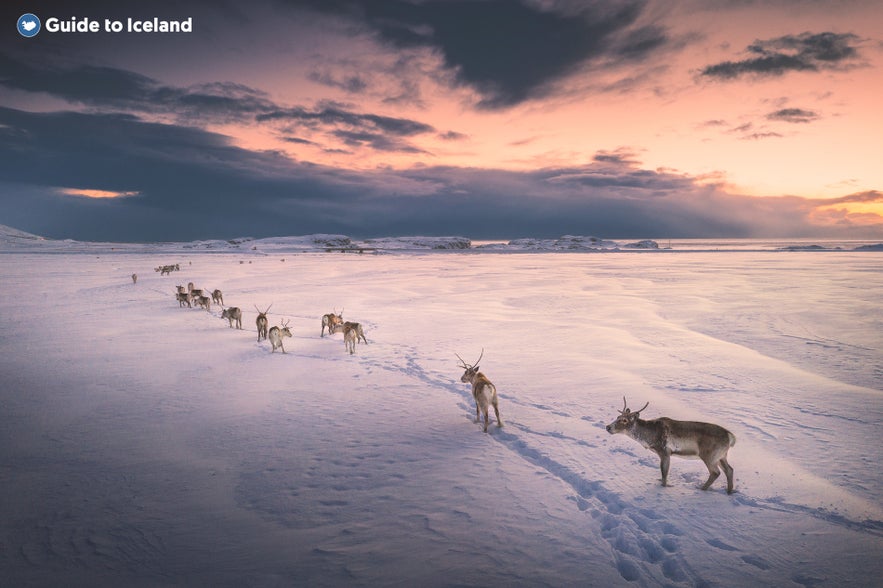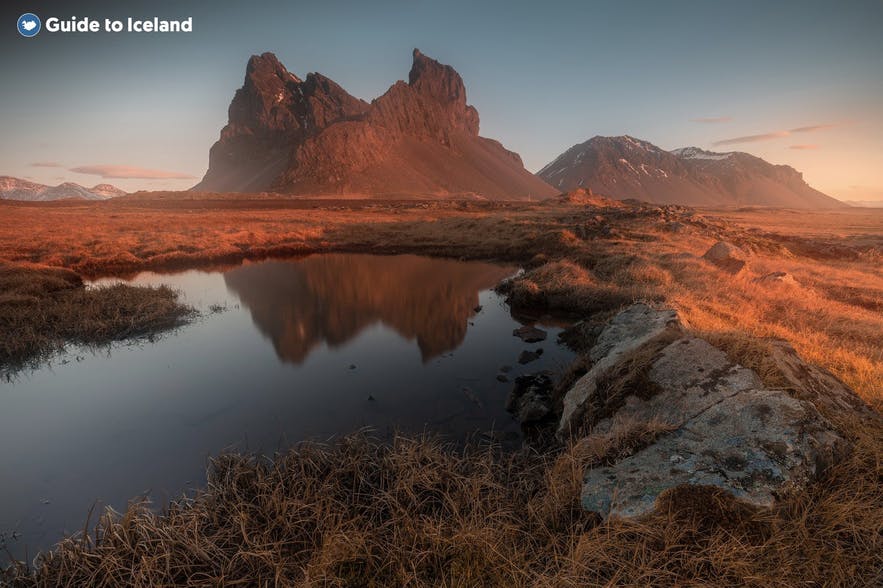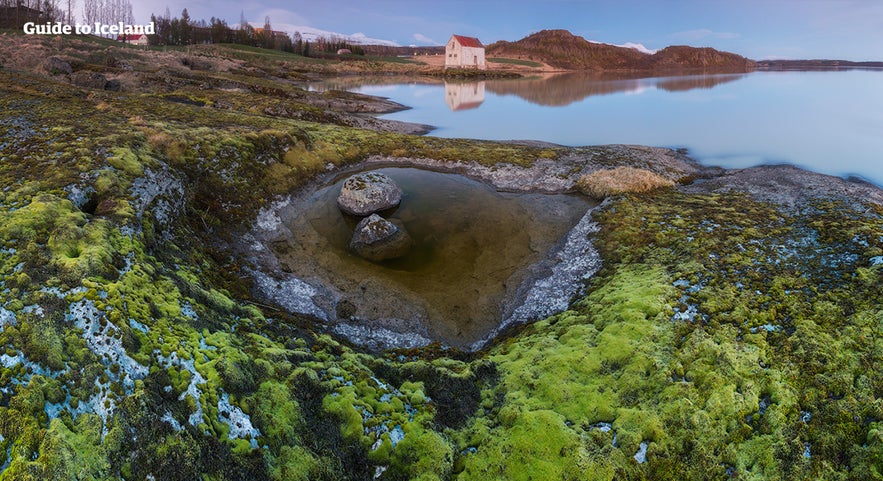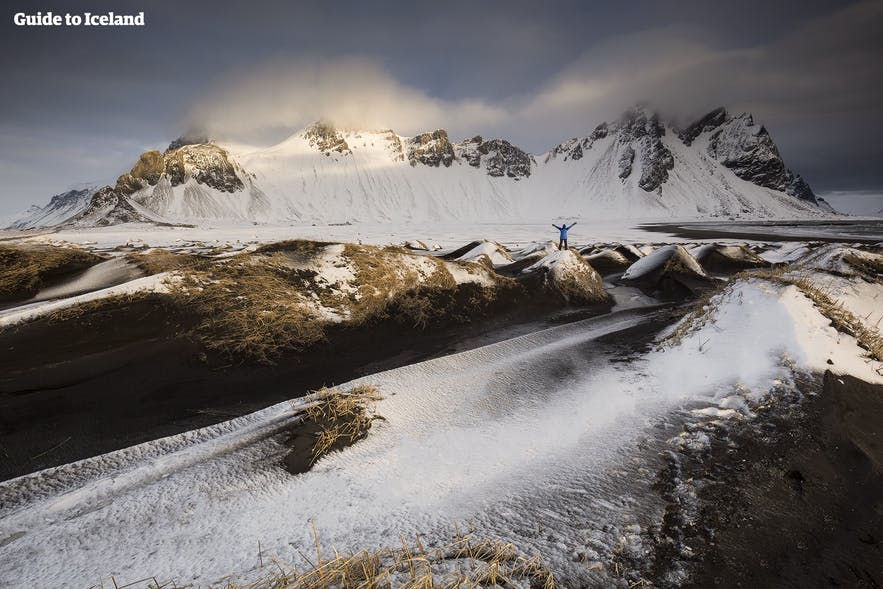
アイスランドの東フィヨルド地方は、南のベールフィヨルズル(Berufjörður)から北の小さな漁村ボルガルフィヨルズル・エイストリ(Borgarfjörður Eystri)まで、120キロメートル(75マイル)にわたる海岸線を指します。
アイスランドの総人口33万5,000人のうち、東アイスランドに住んでいるのはわずか3.2%にすぎません。現地ではAusturlandまたはAustfirðirと呼ばれ、地域全体の面積は22,721平方キロメートルです。このエリアの絶景は東フィヨルドを巡るツアーでお楽しみいただけます。じっくりと観光したい場合は、東フィヨルドのホテルを予約することをおすすめします。
当サイトの情報が信頼できる理由
Guide to Iceland (ガイド・トゥ・アイスランド)は、アイスランドで最も信頼されている旅行プラットフォームです。毎年、何百万人もの旅行者にご利用いただいています。 すべてのコンテンツは、アイスランドに精通した現地の専門家が執筆・監修しており、 常に正確で最新の情報を提供しています。 信頼できる旅のアドバイスをお探しなら、ぜひ当サイトをご活用ください。
東アイスランドの自然
東アイスランドには、切り立った崖に囲まれた多くの細長いフィヨルドがあり、そのほとんどに漁村が点在しています。
観光客からはよく見過ごされがちな東フィヨルド地方ですが、アイスランドの魅力が詰まった場所です。素晴らしい景観、人里離れた漁村、きらめく湖、うっそうとした森、そして伝統的な農場があります。
この地域は、アイスランドで最も日照時間が長く、特に野生のトナカイなど国内の野生動物の生息地としても有名です。
アイスランドでトナカイが生息しているのは、この地域だけです。当初は農業用に連れてこられましたが、うまく収益を上げることができず、それ以来トナカイたちは自由に暮らしています。

夏になると、内陸部と崖地には、かわいらしいパフィンを含む渡り鳥が生息します。
この地域には多くの川が流れており、その河口にはアザラシの群れが暮らしています。豊かな水域はクジラやイルカの餌場となっており、時には海岸からでも見ることができます。
印象的なスナイフェル山(Snӕfell)(西アイスランドのスナイフェルスネス半島とは異なります)は、アイスランドで最も高い独立峰です。その近くには、世界でも特に重要なピンクフット・グース(カリガネ)の営巣地の一つ、高地のオアシス、エイヤバッカル(Eyjabakkar)があります。
ヨーロッパ最大の氷河であるヴァトナヨークトル(Vatnajökull)は東アイスランドの境界まで広がっており、とても大きいためこのエリアのほぼどこからでも見ることができます。
息をのむような海岸線と静かな孤独を求めて、観光客は東アイスランドを訪れます。アイスランドを一周するリングロードの旅の外せない立ち寄り先のひとつです。

東フィヨルドには、たくさんのアクティビティがあります。自然の中を気持ちよく散策するのがお好みなら、ハイカーの楽園ボルガルフィヨルズル・エイストリ(Borgarfjörður Eystri)がおすすめです。地元の伝説では、この地域にはエルフやアイスランドの「隠れた民」が住んでいると言われています。
また、ストゥズラギル渓谷(Studlagil Canyon)には、信じられないほど美しい玄武岩の柱状節理があります。渓谷に行くにはハイキングが必要ですが、地質に興味のある方や自然が大好きな方には、是非とも訪れていただきたい場所です。
また東アイスランドには、リトラネスフォス滝(Litlanesfoss)やヘンギフォス滝(Hengifoss)など、美しい滝もあります。
エイイルススタジル(Egilsstaðir)
東アイスランドには、旅に必要なサービス施設のある町の数が限られています。その一つが、エイイルススタジル(Egilsstaðir)です。
エイイルススタジルには、レストラン、博物館、ショップ、ガソリンスタンド、そしてあらゆる予算に合わせた宿泊施設があります。また空港もあるため、観光の時間が限られている方や運転免許を持っていない方でも、レイキャビクから簡単にアクセスできます。

東アイスランドのこの小さな町は、、ハイキング、プール、スパ(特にヴォーク・バス(Vok Baths)がおすすめ)、滝めぐり、趣のある町の散策など、さまざまなアクティビティができることでも有名です。また、素晴らしい文化遺産博物館があり、かつての東アイスランドの人々の暮らしを知ることができます。
この地域には、アイスランド最大の森であるハットルオルムススターザスコゥガルの森(Hallormsstaðarskógur)など、素晴らしい文化的ランドマークもたくさんあります。この森は、ラーガルフリョゥト湖(Lagarfljót)の東岸にあり、湖をよく見ると、湖に住むと言われている恐竜を見つけられるかもしれませんよ。
ハットルオルムススターザスコゥガルの森は、世界中から集められた80種以上の木々で構成されており、740ヘクタールの広さがあります。1910年にはただの小さな、保護された柵の中の木々だったことを考えると、その成長ぶりは驚くべきものです。
またエイイルススタジルでは、Hringrás、Orsteiti Town Festival、ジャズフェスティバルなど、さまざまなジャンルの音楽イベントが毎年開催されています。
のんびりリラックスしたい方には、バッカフィヨルズル(Bakkafjörður)近くにあるセラゥルロイグ(Selárlaug)のプールもおすすめです。このプールは山々に囲まれ、フィヨルドの美しい景色を望むことができ、この地域で最も本物の体験ができる場所の一つとされています。

東フィヨルドの冬は、天候が良ければエイイルススタジル(Egilsstaðir)のような人里離れた地域で、オーロラを見る絶好の機会となります。
セイジスフィヨルズル(Seyðisfjörður)
ヨーロッパ本土やフェロー諸島からフェリーでアイスランドを訪れる人は、セイジスフィヨルズルに到着します。人口700人のこの小さな町は、装飾的な木造建築、スカンジナビアの影響、そしてニシンの漁業で有名です。セイジスフィヨルズルの建設に使われた木材の多くは、18世紀にノルウェーから既製品として運ばれてきました。
町の中心部には虹色に塗られた通りがあり、その先には有名な青い教会があります。
セイジスフィヨルズルは、勢いのある滝、平らな頂上の山々、そして穏やかなハイキングコースに囲まれており、隣接するフィヨルドの素晴らしいパノラマビューを楽しむことができます。
セイジスフィヨルズルやその近郊では、スキューバダイビング、スキー、海釣り、パラグライダー、乗馬などのアクティビティも楽しめます。また、フィヤルザルセル発電所博物館(Fjarðarsel Power Plant Museum)やSkaftfell Centre for Visual Artsなどを訪れることもできます。
ファウスクルーズスフィヨルズル(Fáskrúðsfjörður)
ファウスクルーズスフィヨルズルは、人口わずか700人の村です。東フィヨルドの中心部に位置し、独自の文化を持っています。
最初の入植者はフランス人の漁師たちで、その遺産は今でもこの小さな町に息づいています。彼らは1800年代半ばに初めてここにやってきました。フランス人たちは、アイスランドでの生活に必要なものとして、家屋、病院、港を建設しました。
彼らはこの小さな沿岸の村で、静かに暮らしていましたが、第一次世界大戦が始まると、多くのフランス人が祖国フランスを守るために召集されました。まもなく町から男たちはいなくなりましたが、彼らの遺産は今も受け継がれています。
かつてのフランス人病院を訪れることができ、そこでフランス人入植者たちの詳しい物語を知ることができます。最近改装され、現在はホテルと博物館として使われています。
町の創設者たちへの敬意を表して、町の標識は今でもアイスランド語とフランス語の両方で表示されています。また、フランスのグラヴリーヌ(Gravelines)という町と姉妹都市になっています。
グラヴリーヌでは、アイスランドとのつながりを祝う祭りが年に2回開催されています。1回目は春、漁師たちがアイスランドへ出漁する時期、2回目は秋で、彼らがフランスの海岸に戻ってくる時期です。
ファウスクルーズスフィヨルズルでは、夏にフランスとのつながりを祝う祭りが開かれます。7月は漁の最盛期であり、祝祭もこの時期に合わせて行われます。
釣り好きの人は、近くのダルサゥ川(Dalsá)で手軽に釣りを楽しむことができますよ。
また、ギルサゥ川(Gilsá)沿いの道をギルサゥルフォス滝(Gilsárfoss)まで歩くハイキングもおすすめです。滝の裏側を歩くことができます。
ブレイズダルスヴィーク(Breiðdalsvík)
レイズダルスヴィークは、ファウスクルーズスフィヨルズル(Fáskrúðsfjörður)の南に位置しており、人口わずか140人の小さな村です。ここはハイキングにもってこいの場所で、野生のトナカイを観察するのにも最適です。
ここの黒砂のビーチや、アイスランドで最も長く、最も幅の広い谷であるブレイズダルール(Breiðdalur)へのドライブ旅行もおすすめです。
パプエイ島(Papey Island)
パプエイ島(「修道士の島」)は、アイスランドの東海岸沖にある無人島です。島の面積は約2平方キロメートルで、最高地点は海抜58メートルです。パペイ島への船旅は、毎年夏にデューピヴォーグル(Djúpivogur)から出航しています。
この島は、ゲール人の修道士たち(「パーパル(The Papar)」)にちなんで名付けられました。これらの修道士たちは、北欧の入植者たちよりもずっと前からこの島に住んでいたと考えられています。パプエイ島には10世紀から1966年まで人が住んでいました。
何世紀もの間、この島の住民たちは、サメ漁、アザラシやパフィンの狩猟、そして農場の管理で生計を立てていました。後年には、島に生息するホンケワタガモ(Eider Duck)の羽毛を採取することもありました。
現在は、今でも島に生息している大きなパフィンの群れを見ることができます。また、1966年当時とほぼ同じ状態で残されている灯台、教会、気象観測所など、かつての集落の遺構を見学するのも興味深いです。
東アイスランドの文化
東部の文化の中心地の一つに、フリョーツダルスヘラズ(Fljótsdalshérað)地区にあるスクリズククラウストゥル(Skriðuklaustur)文学研究所(修道院跡)があります。中世には、この場所に修道院がありましたが、その後、宗教センターとなりました。20世紀には、アイスランドの作家グンナル・グンナルソン(Gunnar Gunnarsson)がここを住居としました。
グンナルは、『Aðventa』(The Good Shepherd)、『Svartfugl』(The Black Cliffs)、『Saga Borgaraettarinnar』(he Saga of the One-Eyed Guest)など、多くの傑作を書きました。また、自伝的な小説『Fjallkirkjan』も執筆し翻訳され『The Church on the Mountain』『Ships in the Sky』『The Night and the Dream』など、さまざまなタイトルで知られています。
東部の文化において、フェスティバルは重要な役割を果たしています。セイジスフィヨルズル(Seyðisfjörður)では毎年音楽祭LungAが開催されます。また、Neskaupsstaðurでも、NeistaflugとEistnaflugという2つの、非常に人気のあるフェスティバルが開催されています。
東アイスランドには、多くの町にエネルギーを供給するカウラフニューカル水力発電所もあります。この建設は、アイスランドの環境負荷に関する激しい議論を引き起こしました。この議論は今日も続いています。









